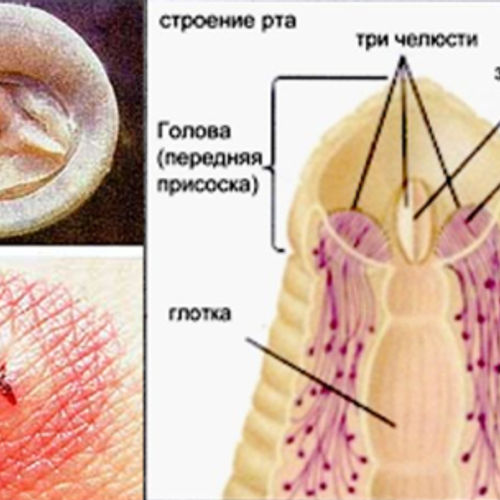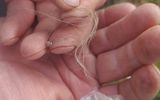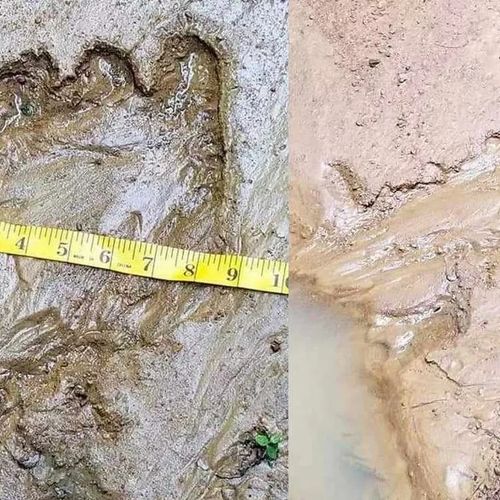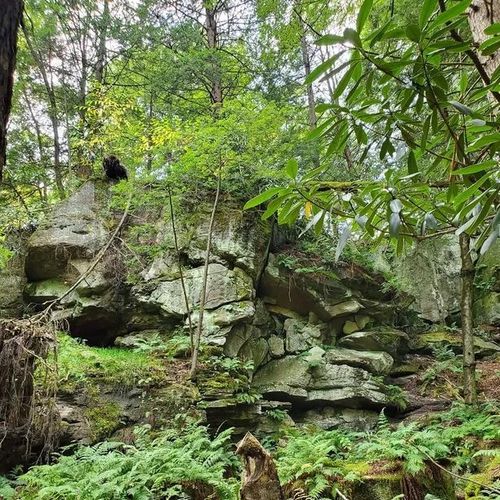| ID | #1666816830 |
| Added | Wed, 26/10/2022 |
| Author | July N. |
| Sources | |
| Phenomena | |
| Status | Hypothesis
|
Initial data
Scientists of the Institute of General Genetics of the Russian Academy of Sciences became interested in the discovery of Yamal hunters claiming that they had discovered "yeti hair".
The hunters captured their discovery on camera. The video shot by Vladislav Tyrlin in the forest of the Shuryshkarsky district shows clay on trees — according to the man, it was left by a snowman who touched the trunks when he passed by. The hunter suggested that the yeti had stained the trees with his hands or paws, and his height far exceeds that of a human.
"There was wool here, I collected it, here are some more pieces left," said Tyrlin, showing where he found the creature's hair.
In addition, hunters drew attention to large footprints near the hut, calling them "inhuman".
According to Candidate of Biological Sciences Alexander Koporikov, his colleagues reacted with skepticism to such a discovery. In their opinion, the yeti would not leave visible traces behind him if he really exists. Despite this, the scientists took the found "wool" and began to study it. The expert stated that the Yamal hunters' find could become a worldwide sensation if it turns out that the hair they found does not belong to any of the known animals.
Earlier it was reported that a geneticist from Oxford University examined the DNA of a creature killed in the Himalayas 30 years ago and passed off as a yeti, and found similarities with the DNA of a polar bear. According to the scientist, the bigfoot may turn out to be a hybrid of a brown bear and a polar bear that arrived in the area of the mountain range from the Arctic north many years ago.
Original news
Naukowcy z Instytutu Genetyki Ogólnej Rosyjskiej Akademii Nauk zainteresowali się odkryciem myśliwych jamalskich, którzy twierdzą, że znaleźli „włosy yeti”.
Myśliwi uwiecznili swoje odkrycie na nagraniu. Wideo, nakręcone przez Władysława Tyrlina pokazuje glinę na drzewach - według mężczyzny pozostawił ją Yeti, który dotknął pni, gdy przechodził obok. Łowca zasugerował, że yeti zabrudził drzewa rękami lub łapami, a jego wzrost jest znacznie większy niż człowieka.
„Tu była wełna, zebrałem ją, zostało jeszcze kilka kawałków” – powiedział Tyrlin, pokazując, gdzie znalazł włosy stworzenia.
Ponadto myśliwi zwrócili uwagę na duże ślady stóp w pobliżu chaty, nazywając je „nieludzkimi”.
Naukowcy najpierw zareagowali na takie odkrycie ze sceptycyzmem. Ich zdaniem yeti nie pozostawiłby po sobie widocznych śladów, gdyby naprawdę istniał. Mimo to naukowcy wzięli znalezioną „wełnę” i zaczęli ją badać. Specjalista stwierdził, że odkrycie łowców jamalskich mogłoby stać się ogólnoświatową sensacją, gdyby okazało się, że znalezione przez nich włosy nie należą do żadnego ze znanych nam zwierząt.
Wcześniej informowano, że genetyk z Uniwersytetu Oksfordzkiego zbadał DNA stworzenia zabitego w Himalajach 30 lat temu i uchodził za yeti, i znalazł podobieństwa z DNA niedźwiedzia polarnego. Według naukowca Wielka Stopa może być hybrydą niedźwiedzia brunatnego i niedźwiedzia polarnego, który wiele lat temu przybył w rejony pasma górskiego z arktycznej północy.
Hypotheses
Famous creatures

There are a huge number of different living organisms on our planet. According to recent estimates, the number of species of organisms on our planet is approximately 7-10 million. However, only 15% of the data are described today.
According to the calculations of Canadians, 2.2 million species live in the world's oceans, 6.5 million on land. There are only about 7.8 million species of animals on the planet, 611 thousand fungi, and 300 thousand plants.
Investigation
Resume
Similar facts
Log in or register to post comments










